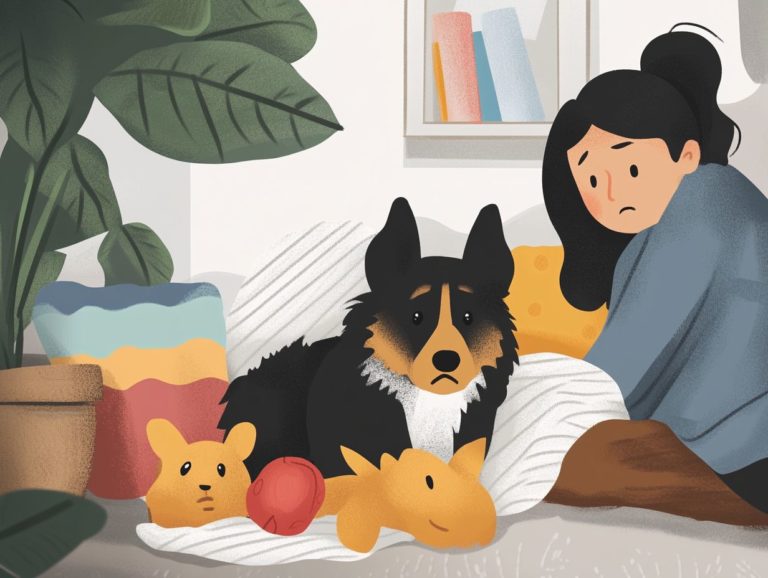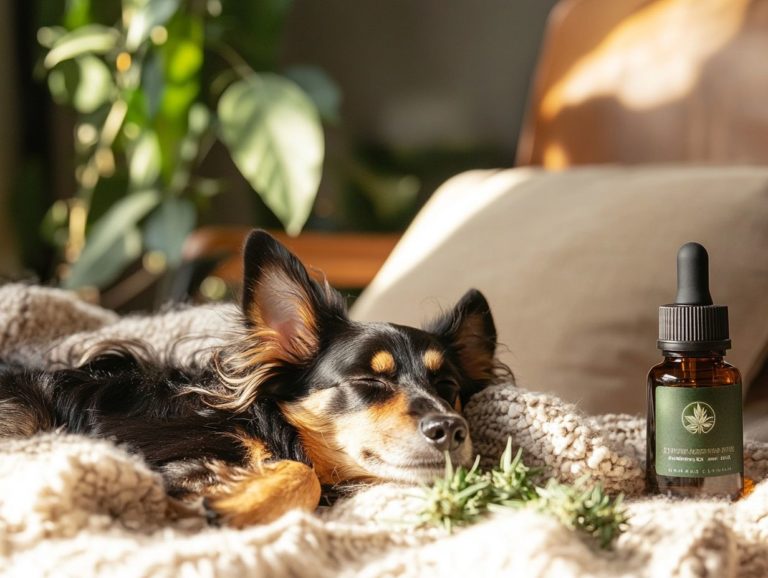How Long Does It Take to Treat Pet Anxiety?
Pet anxiety is a common issue that many furry companions face. It often leaves them feeling stressed and uncomfortable. Understanding the main reasons and triggers is essential for you as a pet owner.
This article delves into how to identify the signs of anxiety, covering both behavioral and physical indicators. It also discusses a range of treatment options, including medication and methods to change a pet s behavior.
It examines the factors that influence the duration of treatment and offers practical tips for managing and preventing anxiety in your pets.
Create a calmer, happier environment for your beloved animals! Ensure they feel secure and loved.
Contents
Key Takeaways:
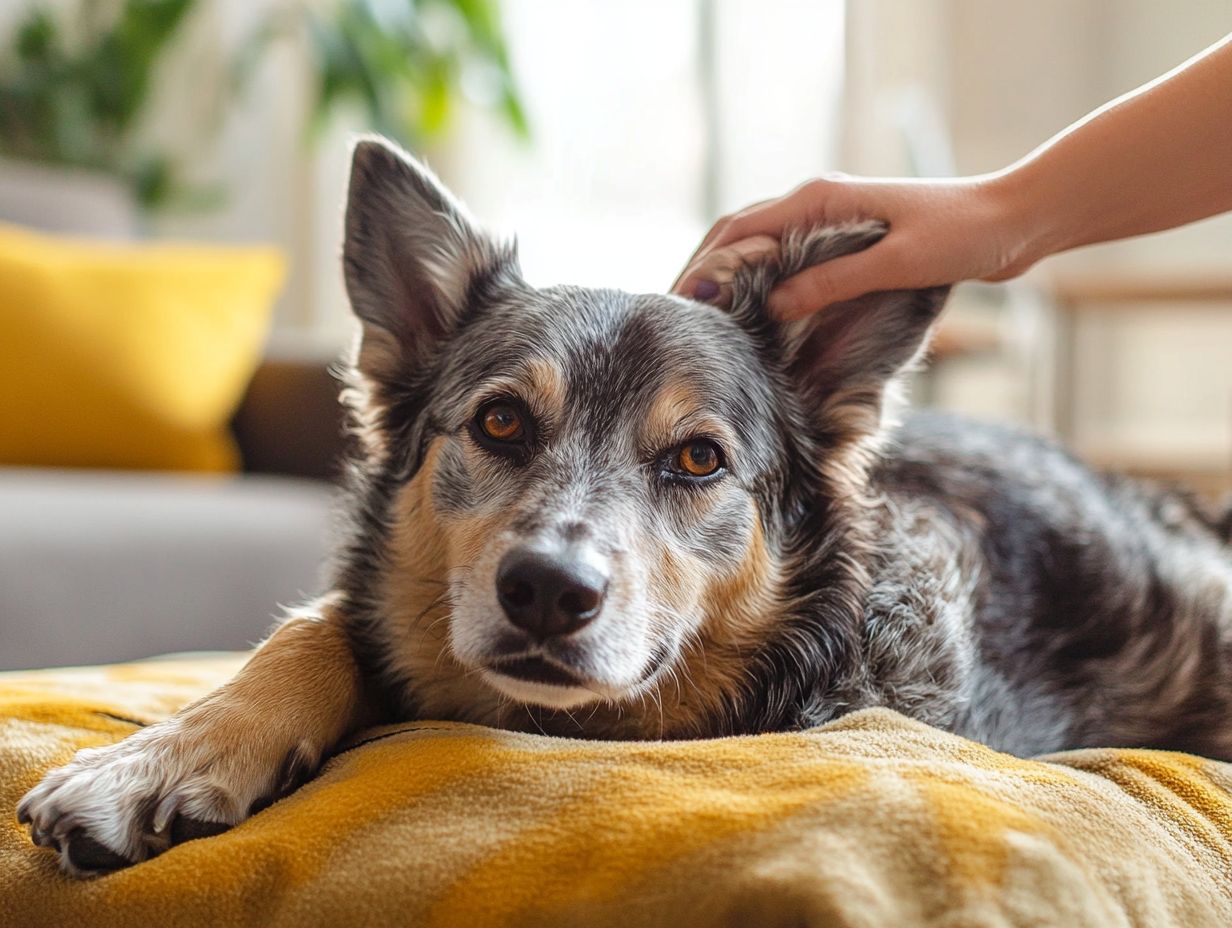
- Pet anxiety can be caused by various factors and can show both behavioral and physical signs.
- Treatment may include medication and behavior therapy, and the duration can vary.
- Preventative measures and supportive strategies are important for managing pet anxiety.
What is Pet Anxiety?
Understanding pet anxiety is essential for you as a dog owner. It involves a spectrum of behavioral challenges, particularly separation anxiety, which many breeds experience. This condition can arise from various anxiety disorders that your dog may encounter.
Recognizing these issues is vital not only for effective treatment but also for improving the overall physical health and mental well-being of your beloved companion. Familiarizing yourself with common causes and stress triggers will enable you to create a thorough treatment plan and seek veterinary assistance when needed.
Causes and Triggers
Dog anxiety can stem from a variety of causes and stress triggers. It is crucial for you to identify the root of your pet’s behavioral issues to address them effectively.
Common triggers often include separation anxiety, which arises when dogs feel distressed when left alone. Changes in routine can also play a significant role, as dogs thrive on predictability and consistency.
Environmental factors, like loud noises from storms or fireworks, can provoke stress responses, while past traumas from abuse or neglect can leave enduring emotional scars.
By pinpointing these specific stressors, you can implement targeted anxiety management strategies. This might involve training techniques that foster a sense of security and calm. Natural therapies like herbal supplements or calming music can also help. Ultimately, these efforts can lead to a happier, more balanced pet.
Identifying Signs of Pet Anxiety
Recognizing the signs of pet anxiety is essential for dog owners. By identifying common symptoms and understanding your dog’s body language, you can effectively address behavioral issues before they escalate.
This proactive approach not only fosters a healthier environment for your pet but also strengthens the bond between you and your furry companion.
Behavioral and Physical Indicators
Behavioral and physical indicators of dog anxiety can reveal themselves in various ways. Changes in appetite and shifts in everyday routines are important signs to watch for.
For instance, you might notice your dog pacing or exhibiting restlessness an inability to settle down that often signals underlying stress. Other concerning signs, such as withdrawal from social interactions or excessive drooling, can also arise.
By carefully observing these symptoms, you can pinpoint anxiety triggers and seek the appropriate intervention.
Engaging with a veterinarian is crucial, as they can evaluate your dog’s physical health and recommend therapies or treatments that may ease anxiety. Timely intervention supports your dog’s emotional stability and significantly enhances their overall quality of life.
Treating Pet Anxiety

Addressing pet anxiety requires a comprehensive strategy that focuses on creating a personalized treatment plan designed specifically for your dog’s unique needs. This plan may integrate effective strategies for pet anxiety, including anxiety medications, natural therapies, and professional dog training to ensure a holistic approach to their well-being.
Medication Options
When managing your dog’s anxiety, you have several medication options at your disposal to help alleviate symptoms. Consider Selective Serotonin Reuptake Inhibitors (SSRIs) like fluoxetine and clomipramine, as well as benzodiazepines for short-term relief. SSRIs help increase serotonin levels in the brain, which can improve mood.
These medications serve unique purposes. SSRIs are typically used for long-term management of conditions such as separation anxiety and phobias. On the other hand, benzodiazepines offer quick relief during particularly stressful episodes, like thunderstorms or fireworks.
Your veterinarian plays a crucial role in your dog’s treatment, so make sure to ask questions and stay informed! They will consider your dog’s specific needs, health history, and any potential interactions with other medications. It’s crucial for you to closely monitor your dog’s response to the prescribed medication, as side effects can vary significantly.
Watch for side effects like drowsiness, changes in appetite, and gastrointestinal upset.
Maintaining open communication with your veterinarian is essential to ensure the best possible outcome for your furry friend.
Behavioral Therapy Techniques
Behavioral therapy techniques are essential in crafting a comprehensive treatment plan for dog anxiety. They focus on modifying your dog s behavior through structured training and natural therapies.
Among these techniques, desensitization is when your dog gets used to something that makes them nervous over time. It allows you to gradually expose your dog to stress-inducing stimuli, helping them build tolerance. Similarly, counter-conditioning transforms your dog’s negative emotional responses to anxiety triggers. For example, you can pair those stressful situations with positive experiences, like treats or playtime it’s a game changer.
Positive reinforcement training further reinforces desirable behaviors, making it a vital tool in shaping how your dog responds to anxiety-inducing scenarios.
When you integrate these behavioral approaches with medication and other effective anxiety management strategies, you create a holistic framework. This equips your dog with the tools needed to navigate their fears more confidently, ultimately enhancing their quality of life.
Factors Affecting Treatment Duration
Several factors can greatly influence the duration of treatment for dog anxiety, particularly the severity of the anxiety and how your individual dog responds to the chosen treatment plan. For a deeper insight, check out understanding the timeline of pet anxiety treatment.
Severity of Anxiety
The severity of dog anxiety can vary widely, from mild behavioral quirks to severe separation anxiety. Understanding this variation is crucial, and you can learn more about best practices for pet anxiety training, as it directly influences how you approach treatment and its duration.
Understanding this spectrum is essential for addressing each dog’s unique needs effectively. A veterinarian’s keen observations, combined with your insights on your pet’s behavior, can offer valuable clues in identifying the specific level of anxiety.
For example, mild anxiety might show up as restlessness or excessive barking, while more severe cases can lead to destructive behaviors and panic. Spotting these signs early on is crucial, as it allows for personalized interventions that can significantly enhance your dog’s quality of life.
By concentrating on individualized treatment plans, veterinarians can provide better support for both you and your pet. If you notice signs of distress, it’s important to know what to do if your pet develops anxiety suddenly. This helps manage and alleviate anxiety symptoms with compassion and effectiveness.
Response to Treatment
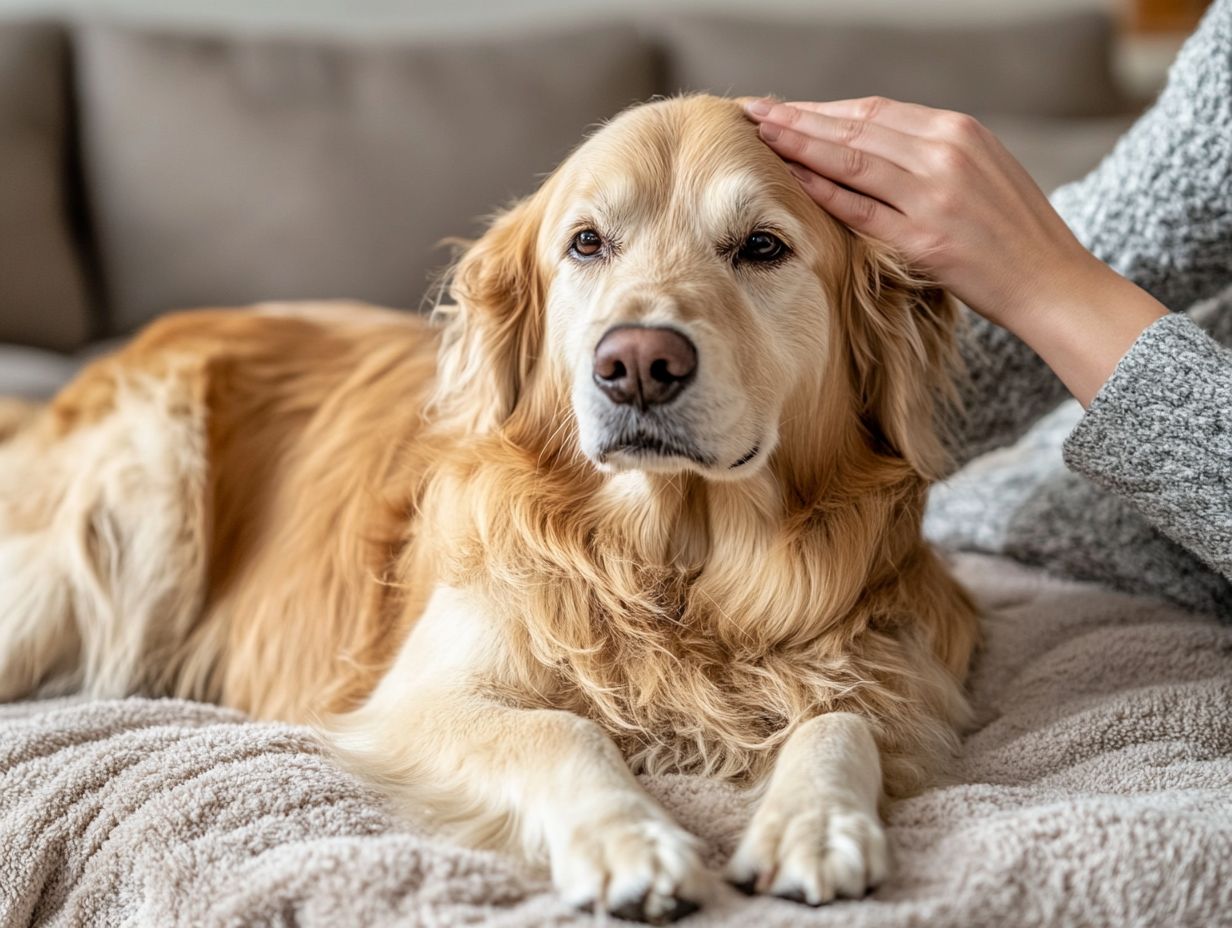
Monitoring your dog’s response to the treatment plan is crucial for effective anxiety management. For more insights, consider what you should know about therapy for anxious pets. This ongoing evaluation enables you and your veterinarian to make informed adjustments as needed.
By closely observing your dog, you can pinpoint which specific medications, dosages, or training methods are most effective. It s essential to keep a detailed log of your dog s behavior and any side effects you notice during treatment. This information will lead to more productive conversations with your veterinary team.
Clear communication is vital, ensuring everyone is on the same page regarding the treatment goals. It also allows for timely adjustments if your dog exhibits signs of distress or insufficient progress. Ultimately, a collaborative approach enhances the likelihood of a successful outcome, fostering your pet s well-being and providing you with peace of mind.
Tips for Managing Pet Anxiety
Managing your pet’s anxiety involves taking proactive measures and implementing supportive care strategies that emphasize prevention and mental stimulation.
By creating an environment where your dog feels secure and at ease, you can significantly enhance their overall well-being.
Preventive Measures
Preventive measures are vital in managing your dog’s anxiety. They focus on understanding stress triggers and applying effective training techniques to minimize anxiety-inducing situations.
Regular visits to dog parks can greatly enhance your dog’s social skills and comfort around other animals. This can help reduce anxiety during interactions.
Engaging in consistent training sessions strengthens the bond between you and your pet and establishes a structured environment that alleviates stress.
Utilizing anxiety prevention techniques, such as calming products and creating safe spaces, can significantly improve your dog’s emotional well-being. Don t underestimate the invaluable role of veterinarians in this journey; they provide personalized recommendations and guidance.
Supportive Care Strategies
Implementing supportive care strategies for your dog’s anxiety is essential for enhancing their overall physical well-being and emotional stability.
These strategies boost your pet s comfort and happiness, complementing formal treatment plans. For instance, incorporating natural therapies like CBD oil has become quite popular for its calming effects.
Creating a calm living environment is crucial. Utilizing soft lighting, soothing music, and designated safe spaces allows your dog to retreat and feel secure when they need it most.
Engaging in regular exercise and mental stimulation also plays a vital role in releasing pent-up energy, promoting a balanced state of mind.
Together, these supportive measures cultivate a nurturing atmosphere that fosters emotional health and enhances your dog’s overall quality of life.
Frequently Asked Questions
How long does it take to treat pet anxiety?
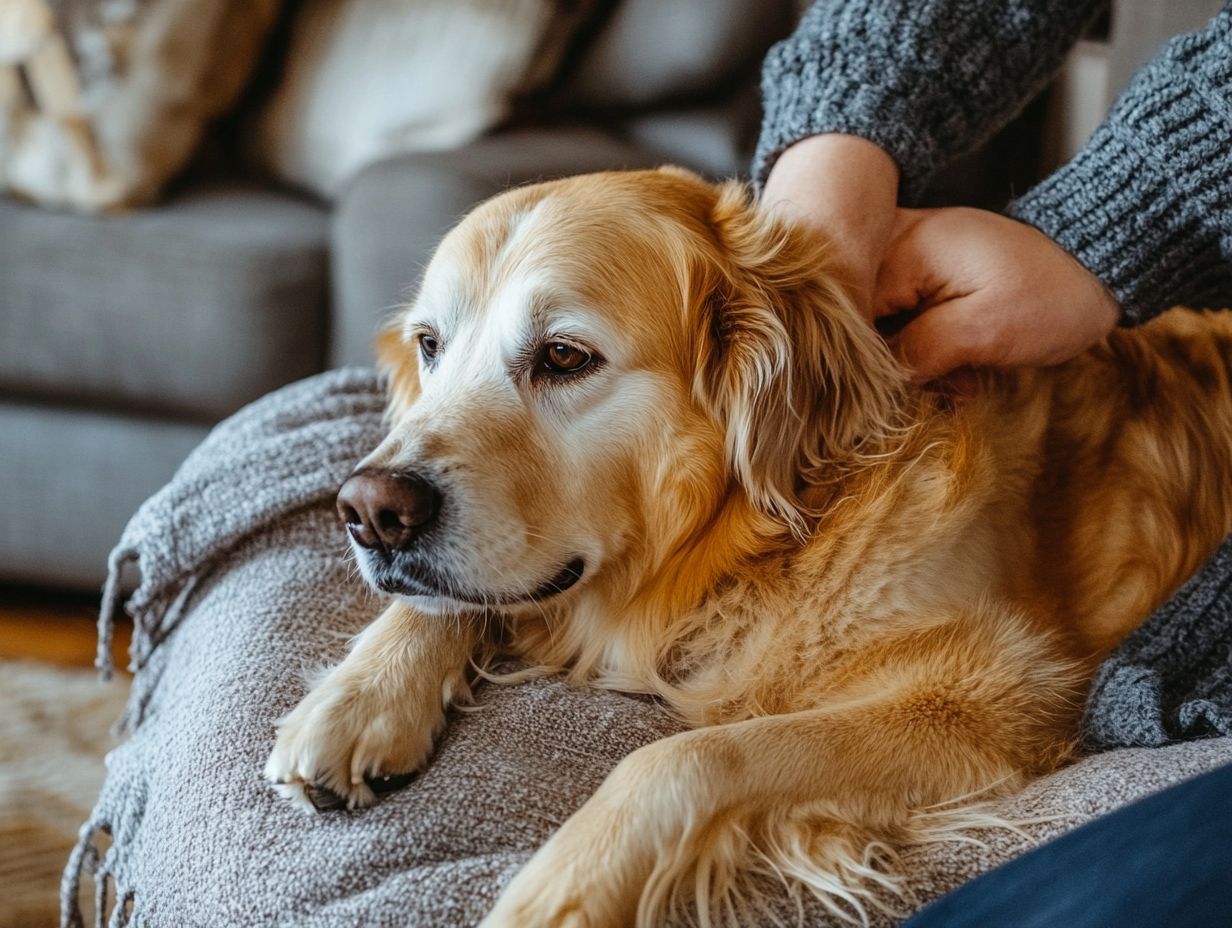
Wondering how long treatment takes? The duration of treatment for pet anxiety varies. It depends on the severity of the anxiety and your pet’s individual response to treatment. For more information on the timeline and related expenses, you can check out the costs of treating pet anxiety. It can take anywhere from a few weeks to several months to see improvement.
What are the common methods used to treat pet anxiety?
The most common methods used to treat pet anxiety include behavior modification techniques, medication, and natural remedies. To ensure the best results, it’s important to periodically evaluate your approach; you might wonder how often you should reassess your pet’s anxiety. These methods can be used alone or in combination to effectively manage anxiety.
Can pet anxiety be cured?
Pet anxiety cannot be cured, but it can be effectively managed. With proper treatment and ongoing care, exploring natural remedies for pet anxiety can help control and minimize the issue, allowing your pet to live a happy and healthy life.
Is there a quick fix for pet anxiety?
No, there is no quick fix for pet anxiety. It requires time, patience, and consistency to effectively treat it, and knowing how to choose the right anxiety treatment for pets can make a significant difference.
Quick fixes may offer short-term help. However, they often ignore the root cause and can worsen the issue over time.
Are there any natural remedies for pet anxiety?
Yes, several natural remedies can help reduce pet anxiety. Options include pheromone sprays, calming supplements, and essential oils.
Always consult your veterinarian before trying any remedies. This ensures they are safe for your furry friend.
How can I help my pet overcome anxiety?
You have the power to help your pet feel better! Create a safe, secure environment for them.
Be patient and understanding as they adjust. Follow the treatment plan your veterinarian recommends.




